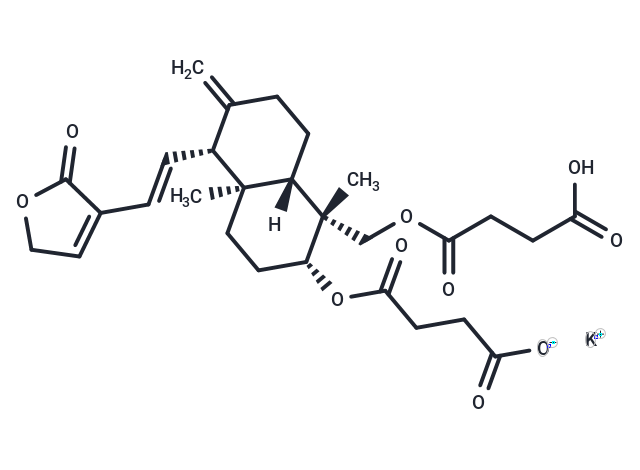Shopping Cart
Remove All Your shopping cart is currently empty
Your shopping cart is currently empty
Kalii Dehydrographolidi Succinas (Dehydroandrographolide Succinate Potasium Salt) is a natural compound with anti-virus infection activity.

| Pack Size | Price | USA Warehouse | Global Warehouse | Quantity |
|---|---|---|---|---|
| 5 mg | $31 | In Stock | In Stock | |
| 10 mg | $48 | In Stock | In Stock | |
| 25 mg | $82 | In Stock | In Stock | |
| 50 mg | $118 | In Stock | In Stock | |
| 100 mg | $176 | In Stock | In Stock | |
| 200 mg | $259 | In Stock | In Stock | |
| 1 mL x 10 mM (in DMSO) | $51 | In Stock | In Stock |
| Description | Kalii Dehydrographolidi Succinas (Dehydroandrographolide Succinate Potasium Salt) is a natural compound with anti-virus infection activity. |
| Kinase Assay | In vitro kinase assay is based on a filter binding assay, using the recombinant GST-fused kinase domains expressed in baculovirus and purified over glutathione-sepharose, γ-[33P]ATP as the phosphate donor, and poly(Glu:Tyr 4:1) peptide as the acceptor. Each GST-fused kinase is incubated under optimized buffer conditions [20 mM Tris-HCl buffer (pH 7.5), 1-3 mM MnCl2, 3-10 mM MgCl2, 3-8 μg/mL poly(Glu:Tyr 4:1), 0.25 mg/mL polyethylene glycol 20000, 8 μM ATP, 10 μM sodium vanadate, 1 mM DTT] and 0.2 μCi γ-33P ATP in a total volume of 30 μL in the presence or absence of a test substance for 10 min at ambient temperature. The reaction is stopped by adding 10 mL of 250 mM EDTA. Using a 384-well filter system, half the volume is transferred onto an Immobilon-polyvinylidene difluoride membrane. The membrane is then washed extensively and dried, and scintillation counting is performed. IC50s for compounds are calculated by linear regression analysis of the percentage inhibition[1]. |
| Synonyms | Dehydroandrographolide Succinate Potasium Salt, Ddhads |
| Molecular Weight | 570.67 |
| Formula | C28H35KO10 |
| Cas No. | 76958-99-1 |
| Smiles | C[C@]12[C@@](CCC([C@H]2/C=C/C3=CCOC3=O)=C)([H])[C@@](C)([C@@H](CC1)OC(CCC([O-])=O)=O)COC(CCC(O)=O)=O.[K+] |
| Relative Density. | no data available |
| Storage | keep away from direct sunlight,store under nitrogen | Powder: -20°C for 3 years | In solvent: -80°C for 1 year | Shipping with blue ice/Shipping at ambient temperature. | ||||||||||||||||||||
| Solubility Information | DMSO: 9.42 mg/mL (16.51 mM), Sonication is recommended. | ||||||||||||||||||||
Solution Preparation Table | |||||||||||||||||||||
DMSO
| |||||||||||||||||||||
| Size | Quantity | Unit Price | Amount | Operation |
|---|

Copyright © 2015-2025 TargetMol Chemicals Inc. All Rights Reserved.